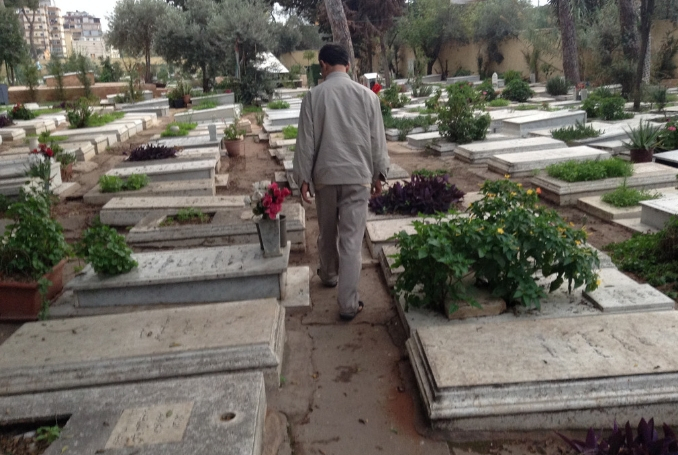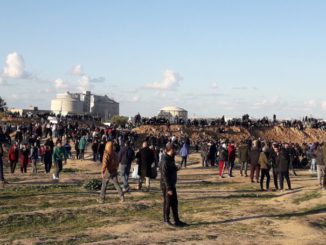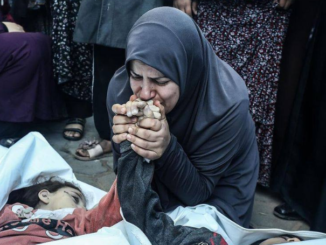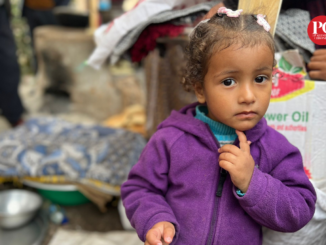
By Marion Kawas
The Palestinian camps in the south of Lebanon have a special place in the history of resistance to Israeli aggression and expansionism. They, along with their Lebanese compatriots, were often on the front lines of facing constant Israeli air raids, incursions and then, of course, the brutal Israeli invasion of 1982. All this defined what these camps stood for and still stand for, but also took a heavy toll on the population.
Returning to Lebanon after more than 4 decades was an experience that held personal and political implications. I was returning to where I got my first real exposure to the Palestinian struggle, which was to shape the trajectory of my activism forever. Most of that inspiration came from the Palestinians I had met in the refugee camps, both from around Beirut and in the south.
Driving south from Beirut in the 1970s was a very different journey than today … now there is a new highway compared to the old coast road, which was full of enormous potholes that literally destroyed the axles of cars. The first part of this new road comes with a high wall at the side that blocks the view of the sea, a continuation of what has happened along much of the privatized Beirut coastline. The amazing citrus groves from 4 decades ago (that produced the largest oranges I’ve ever seen) have been joined by huge banana plantations, broken by areas of frantic construction and burning piles of garbage. As you approach Saida (Sidon) and Tyre, it is apparent that both those towns are also caught in the grip of the building and development frenzy that seems to define Lebanon.
Unlike Beirut, most of the refugee camps in the south are still majority Palestinian residents and perhaps due to these demographics, there is more continuity with the past. Although physically these camps bear the same features as others in Lebanon (the narrow lanes and the overhead patchwork of electric wires), in the Burj el Shamali camp near Tyre, for example, the sense of pride in being Palestinian seemed more palpable, less diluted. The camp still holds a certain social cohesion, with hospitable extended families and a close-knit community that shares a common history and a common destiny.

In Saida, after visiting displays marking the International Day of Solidarity with the Palestinians (which were happening in many places), we went to visit the largest Palestinian refugee camp in Lebanon, Ain Al-Helweh. It is also where the great Palestinian cartoonist Naji al Ali grew up and gained the inspiration for his Handala character. He is reported as having said when introducing Handala to his readers:
“I am Handala from the Ain Al-Helwa camp. I give my word of honor that I’ll remain loyal to the cause…”.
And since then, Handala has become synonymous with staying true to the Palestinian right of return, a commitment embodied more in the Palestinian refugee camps than anywhere else.
I remember being in Ain Al-Helweh camp in 1973 when an Israeli air raid happened. The jets came in low and the sound alone was terrifying. But the kids in the camp were very composed, collected their younger siblings and dashed for the nearest place of shelter. In a way that was both moving but so far beyond their years, you got a small glimpse into how these Palestinian kids were ripped out of childhood at a young age.
Ain Al-Helweh camp today is fraught with conflicts and internal dissension. The Lebanese government has erected a heavily fortified checkpoint at the camp, which almost resembles an international border crossing. There are government checkpoints at most of the camps, but one is usually waved through without much fanfare. At Ain Al-Helweh due to recent armed clashes in the camps and the infiltration of extremist Islamist elements, any foreign passport holder must have prior permission to enter.
We had received such permission but were still refused entry to the camp on arrival, whether due to bureaucratic mix-ups as was claimed or other reasons, we were not sure. We were saddened but also found it ironic that veteran Palestinian activists from abroad, who had followed all the necessary steps and came with several local hosts and who only wanted to document the Palestinian reality, were not able to visit this important camp.
In Lebanon, there are many restrictions on Palestinians in the refugee camps, be it in education, work, building regulations and even access to medical care. A tragic example just last month was the death of a 3 year-old Palestinian child, Mohammed Wahbah, from Nahr el Bard camp near Tripoli in the north, due to the refusal of 3 different Lebanese hospitals to treat his serious condition in a timely manner. Many of the camp’s residents felt the denial of treatment was because the boy was Palestinian and the family lacked the necessary financial resources; they held both UNRWA (who is responsible for health and education for the refugees) and the Lebanese government responsible. This feeling amongst Palestinian refugees of near-abandonment by official forces is both justified and becoming wide-spread, as UNRWA shrinks its services and the lack of access to host country services bites even harder.
The camps in and around Beirut face their own unique set of social problems, especially with the influx of new refugees from other countries; given the overcrowding, lack of opportunities and crushing poverty, it is not surprising that one of those problems is drug abuse. Many people expressed the opinion that forces antagonistic to Palestinian liberation have played a key role in facilitating the flow of drugs into most of the camps, something that certainly has precedent in historical examples around the world. In Burj al Barajneh camp, Palestinian resilience has also taken the form of establishing a drug rehab centre that has been developed completely independent of “official” forces, as substance abuse is still considered a taboo subject. The facility was amazing, and most of its construction and décor was done by the people it was serving; it also holds a strong attachment to Palestine and its history, and its workshop produces multiples statues that honor Naji al Ali and Handala.

We also toured several offices in Mar Elias camp, a smaller camp in Beirut that is marginally “better off” economically. We learnt more about the Aidoun organization that highlights the fight for the right of return and the Majed Abu Sharar Media Foundation, which runs workshops for young Palestinians in the camps and educates and trains them in journalism and social media. Majed was a well-known Palestinian journalist, writer and director of the PLO Information Department, who was assassinated in Rome in 1981.
The Foundation is run by his daughter Samaa Abu Sharar, whose insights were invaluable in grasping the dynamics that exist today in the camps. As Samaa explained in a 2017 interview:
“My father was a firm believer in the power of the media and he understood, long before many others, that it can be an effective weapon. He worked hard in an effort to unify the Palestinian message, to reach people in different corners of the world in a language they understand, and to mobilize as many supporters as possible for the Palestinian cause.”
Lebanon is a microcosm of all the competing forces in the region, and in that context, schemes to liquidate and manipulate the Palestinian refugees and their demands abound. Palestinian refugees in Lebanon have a long and proud history of being one of the vanguards in defending and articulating the Palestinian right to return to their homeland and the need to “remain loyal to the cause” (to quote Handala’s creator).
They embody the spirit of Sumoud, or steadfastness; their Sumoud means many things, be it resistance, resilience, adaptation or just existence in the face of overwhelming odds against them. This is the Sumoud that puts the current Palestinian leadership to shame; this is the Sumoud we must honor and support.
(Click to read Part I of this article, entitled: Ghosts of Palestinian Resistance in Beirut.)
– Marion Kawas is a member of the Canada Palestine Association and co-host of Voice of Palestine. She contributed this article to PalestineChronicle.com. Visit: www.cpavancouver.org.








I am from Vancouver,Canada and I wanted to say that it is good to hear about Hannah Kawas’s trip to Lebanon.It must have brought about a lot of memories of Lebanon in the 1970s.It looks like the Palestinians in Lebanon are as Revolutionary as they were in the 1970s.It must be good to see Lebanon after all these years.